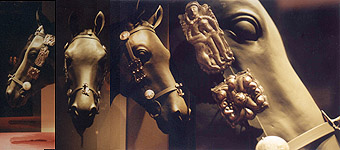
|
Photo ©HK/HS/BRAMA
From the installation of the Gold of the Nomads exhibition at the Brooklyn Museum of Art. |
Were Scythians the earliest Ukrainians?
Not quite, according to what Dr. Denys Kozak, Deputy Director of the Institute of Archeology of the National Academy of Sciences of Ukraine, tells us. Remnants of Scythian culture are clearly evident among Ukrainian traditions, but it would be difficult to hypothesize exactly what, if any, hereditary component remains from this ancient civilization.
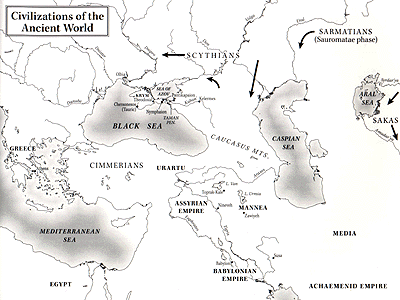
- ©The Walters Art Gallery, Scythian Gold (Catalogue)
Path of Scythian migration
|
Kozak's reticence is echoed by other scholars. According to Lada Onyshkevych, PhD, (Scythian Gold, 1999), "Archaeological evidence suggests that these nomadic peoples [i.e., Scythians] moved into the area from the east sometime around the seventh century BC and may have mixed to some degree with the local populations." Onyshkevych writes further that "While [Greek historian] Herodotus refers to some of the peoples as 'agricultural Scythians,' it is not clear if there was an ethnic connection, perhaps through intermarriage, between Scythians and local tribes. Some scholars, such as Murzin (1996), consider the agricultural inhabitants of the steppes to be related to the Scythians, and the forest-steppe dwellers to be proto-Slavs. Others consider that none of the other tribes listed by Herodotus was related to the Irano-lingual Scythians."
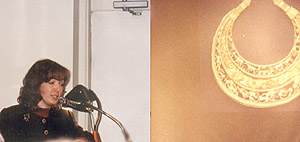
Photo ©HK/BRAMA
Dr. Lada Onyshkevych conducted a lecture about Scythian Gold at the The Ukrainian Museum in October 1999. She is one of the contributing authors to the book Scythian Gold: treasures from ancient Ukraine which was published to complement the current exhibit at the Brooklyn Museum of Art.
|
In Russian Land Soviet People (1968), author James Gregory draws a similar conclusion. "The arrival of the Scythians was no new feature of steppe life. During successive nomadic invasions, some Slav and other communities in the western steppe, in spite of conflict with the nomads, had continued to farm their lands and raise cattle, sometimes serving on the armies of their nomad rulers, whose tax-gatherers and merchants they supplied with tribute. Intermarriage probably added new strains to Slav stock both before the Scythian period and later during the invasions of the Avars, Huns, and other peoples. This may account for the relatively high proportion of people in the "B" blood group (common today in Central Asia and dominant in Mongolia) in the Don and Dnepr [sic] basins." (p.94) The passage may suggest that Gregory concludes that indigenous peoples mixed with nomads prior to and after the Scythian presence, but not with the Scythians themselves. However, he later writes that, "By the fifth century BC there were Scythian and Slav-Scythian settled agricultural communities in the [Ukrainian] steppe, especially in the middle Dnepr [sic] basin and the Kiyev [sic] and Poltava districts." (p.96) The use of the phrase "Slav-Scythian" may be a reference to agricultural communities where intermarriage among Scythians and local peoples was commonplace.
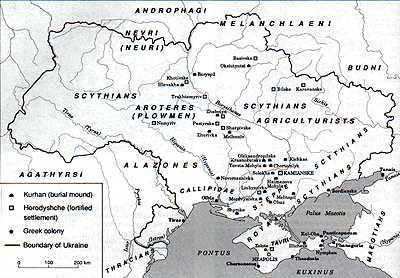 Map of Scythia
Map of Scythia
|
The Encyclopedia of Ukraine describes them as a "bellicose" Indo-European tribe. Those that inhabited the steppe were "nomadic herders of horse, sheep and cattle," while "those in the forest-steppe were more sedentary cultivators of wheat, millet, barley and other crops. (Some scholars believe that those agriculturists may have been the predecessors of the Slavs.)" The Scythians were talented artisans, hunter, fishermen, and savvy traders. Perhaps most of all, the Scythians were known for their abilities as equestrians and expert archers. "They raised and trained horses extensively, and virtually every Scythian male had at least one mount. They lavished care and attention on their horses and dressed them in ornate trappings. Saddles and metal stirrups were not used by the Scythians, although felt or leather supports may have been. The foremost weapon of a Scythian warrior was the double-curved bow, which was used to shoot arrows over the left shoulder of a mounted horse."
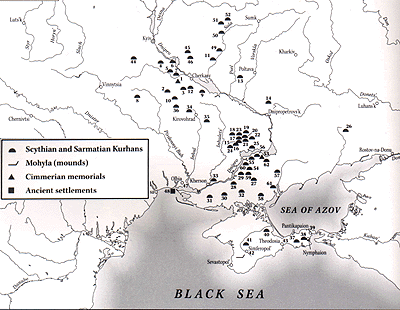
- ©The Walters Art Gallery, Scythian Gold (Catalogue)
Excavation sites of artifacts included in the "Gold of the Nomads" exhibition.
|
The Scythians originated in central Asia, but evidence of their nomadic lifestyle reaches into India, and shows a westward path into Armenia, Ukraine, Hungary and even eastern Germany. They appear to have ended their migration and finally settled in the steppes of Ukraine, as the large number of Scythian "kurhany" or "mohyly" burial mounds found on this territory implies. While no conclusive evidence has been provided to indicate a racial bond between the ancient Scythians and contemporary Ukrainians, "There can be little doubt that the language of the indigenous population of the steppe was affected by contact with the Scythians, and they most probably adopted some of the customs and ideas of their rulers." (Gregory, p.96).